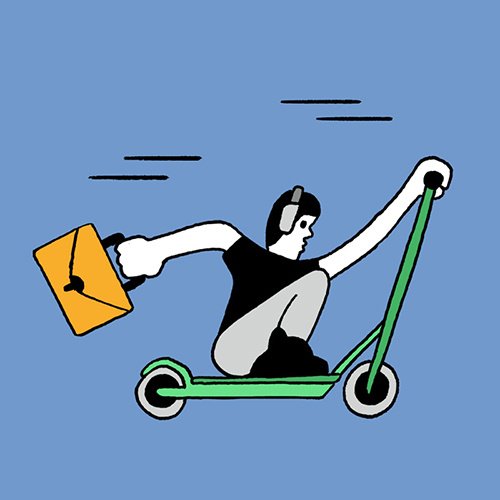How 500 million commuters survive the daily journey to work
Feb 04, 2019
8 mins


Have you ever heard of “commuting”? In his book Rush Hour: How 500 million commuters survive the daily journey to work, Iain Gately writes about the history of commuting and lists the issues related to these daily travels, between one’s home and place of work.
Travelling some distance between one’s home and place of work, also known as “commuting”, has long established a physical separation between work and private life. It’s something many of us are familiar with and take for granted. Going to and returning from work is now part of the daily life of at least half a billion people on the planet.
Yet the history of commuting is far more recent—and fascinating—than one might think. In Rush Hour: How 500 million commuters survive the daily journey to work (2014), Iain Gately offers the first close examination of commuting. It traces its past, present and future and describes the contrasting experiences of commuters: from the crush-loaded salarymen of the Tokyo metro to the road-rage afflicted middle managers of America.
According to Gately, commuting has dictated the growth of cities, been proving ground for new technologies and offered millions of individuals a better life. It’s also shaped the way we work and organise our activities. There used to be no separation between work and life: peasants, craftsmen and even the first factory workers used to live where their work was. The 19th-century rail revolution transformed the spatial organisation of work. Then the automobile revolution created the suburbs and shaped our modern culture.
Commuting is now decried as a plague and a source of pollution. But Gately’s study of the practice is overwhelmingly positive. We are, he writes, like hunter-gatherers, programmed biologically to travel between our hunting grounds and hearths. What if we actually needed it? His entertaining history provides a must-read perspective on a daily practice we tend to take for granted and view negatively. “Little do ye know your own blessedness; for to travel hopefully is a better thing than to arrive”, wrote R. L. Stevenson.
“Travelling to work gives us time ‘to prepare a face to meet the faces that you meet’, and enables us to escape being bound to the soil or trapped in a city. Perhaps rather than lamenting the commute we should revive the pioneer spirit that inspired the first generation of commuters.”
- Iain Gately in Rush Hour: How 500 million commuters survive the daily journey to work.
Commuting: it all started with the British railway revolution
The history of commuting is surprisingly recent. In the 19th century, as cholera epidemics struck the London slums where factory workers lived five to a room and adults had a life expectancy of 35 years, London became less habitable and the rich developed a desire “to separate hearth and hunting ground—to live somewhere healthy and work where it was most profitable”. The practice of commuting was made possible by a new technology: steam-powered transportation.
From the 1830s onwards, Britain, and then the rest of the industrial world (starting with the east coast of the United States), was transformed within fifty years by the railways. At the beginning, trains were designed mostly for the transportation of materials and goods, but soon the transport of passengers took off. From one million passenger journeys in 1840, the figure jumped to 154 million in 1860 and 316 million in 1870. Commuting had begun.
The first class of commuters were educated and wealthy. They were the pioneers who transformed cities, space and our definition of time. “Punctuality was an obsession of early commuters: they had to change the way they thought about time (…) Before the railways appeared, only princes were expected to be precise. Most Britons divided their days into mornings and afternoons rather than hours and minutes.”“The railways needed to operate to a standard hour, if nothing else to prevent collisions.” That’s how most operators adopted “railway time”, i.e. Greenwich Mean Time (GMT). Those people who still followed their village hour missed the train while those who wanted to catch it started to buy new watches. At the time, scientists wondered whether this new fear of being late didn’t cost everyone their peace of mind.
Commuting also transformed social norms. In trains a new code of silence developed among commuters and railway travellers. Indeed trains mixed different sorts of people but Victorians were “acutely class-conscious” and didn’t want to risk getting too familiar with someone from a lower class. When conversations did occur, the code was that the connection should end with the journey. Another solution was to read books and newspapers, which is why the railways caused a surge in literacy in the UK. New chain stores like W.H. Smith began to thrive and publishers supplied them with special railway editions.
The railways started to change the patterns of settlement in Britain. Commuters dreamed of better places to raise their children. Commuting “was redrawing the map, benefiting some locations at the expense of others.” A new passion for gardens and the outdoors characterized the life of those first commuters. It created the suburban way of life.“Between 1877 and 1904, every Wimbledon champion was British, many of them the children of commuters.”
As the nineteenth century progressed, commuting became affordable to more and more people. London’s suburbs grew by 50% per decade between 1861 and 1891. This growth was supported by the creation of underground railways whose first line—the Paddington to Farringdon service—was built in the early 1860s. The underground lines transformed London within a radius of 30 miles.“The separation of work and home had become a new norm for the middle strata of British society, as had the commuting that connected them.”
For the working class, change took time. Most workers “were still crowded together in insanitary lodgings in city centres, or in tenements within walking distance of their places of work”. Things started changing in the 1880s after politicians decided to make trains more available to the masses to tackle the housing problem. The 1883 Cheap Trains Act was the first step.
The automobile revolution gave commuting a second life
New motorcar designs were developed in many countries but the automobile revolution was really an American revolution. “By 1900 automobiles were in commercial production in France, Germany and Britain, albeit as toys for the rich rather than practical working vehicles. Their transformation from a ‘luxury for the few to a conveyance for the many’ took place in America”. Henry Ford’s Model T made cars available to working men. By 1920 auto-commuting had begun. It gave people an unprecedented sense of freedom. It liberated cities from the problem of horse pollution. In New York City horses produced 2.5 million pounds of manure and 60,000 gallons of urine a day! And horse corpses blocked the streets.
New infrastructures, rules, codes and settlements were developed. Driving had to be learned, taught, and coordinated. New roads, fuelling stations, fuel standards and parking spaces had to be created. By 1939, motorcars had become the main form of commuter transport in America (at the expense of public transport). The spread of suburbia accelerated after World War Two: “nearly four million new homes were constructed between 1946 and 1951, most of them on the assumption that their owners would drive to work.” Garages became a common feature of modern architecture.
The new suburbs, created to give commuters a better life, were soon decried as ‘boring’ and ‘uniform’. Historian Lewis Mumford called them “a multitude of uniform, unidentifiable houses, lined up inflexibly, at uniform distances, on uniform roads, in a treeless, communal waste, inhabited by people of the same caste, the same income, (who eat) the same tasteless prefabricated foods, from the same freezers, conforming in every outward and inward respect to a common mold”. As suburbs grew and spread, congestion made commuting into a very static experience at rush hour.
Auto-commuting spread more slowly in other countries, because of cultural and infrastructural obstacles. Driving did become the main mode of commuting in the rest of the world in the second half of the twentieth century, but other two-wheeled alternatives spread: bicycles and Vespas in Italy, ‘comrade’ bikes in China, etc. Today in Britain,“cycling to work is the fastest-growing form of commuting”. And cyclists are the most positive about commuting.
The hell of commuting
Today commuting has a bad rep. For those who commute in trains and metros, rush hour has become synonymous with “crush loading”, i.e. being crammed together in high density. “How do we tolerate, indeed voluntarily submit to, being stuffed into spaces deemed unfit for pigs?” The answer lies in the “freeze, fight or flight” hypothesis. “In some circumstances, instead of fleeing or fighting, staying still and trying to minimize one’s physical presence may be the best response. Many other species of animal ‘play dead’ when threatened.” But there is another interesting explanation: in fact, through a phenomenon known as “collective resilience” we may in fact be united and abandon our sense of self. This is best illustrated in cases of disaster. For example, during the London suicide bombings of 2005, tube-goers helped one another.
How much overcrowding we tolerate on a day-to-day basis varies with culture. In Japan crush-loading is far more extreme than in Europe. And the problems that come with it are extreme too: sexual harassment and suicides are massive. In India the world’s most overcrowded trains cause dozens of deaths every day in Mumbai alone and public sexual harassment is a national epidemic, which authorities try to address with women-only trains.
The second phenomenon that makes commuting a hell on earth is road congestion and road rage. “Road congestion is the counterpart of crush loading for commuters who travel by car”. People in their cars behave very differently from train commuters. They see their cars as a personal territory that needs to be defended, which “means that car commuters are far more likely to turn violent than passengers on public transport” “The notion that road rage is a special type of anger brought on by congestion has received the most attention in America, where citizens can carry firearms and the potential of road rage to lead to murder is far greater.” Many drivers buy bigger cars to cope, which makes congestion even worse. The sales of large SUVs was very high in the USA in the 1990s and 2000s: “in the road-rage era, drivers conceived of their vehicles as ‘armoured cars for the battlefield’.”
But what if commuting still made us happy?
Every study assumes commuting is entirely negative, but the author suggests it matches our hunter-gatherer nature. We may in fact like commuting. It has given us tremendous opportunities and satisfied many of our aspirations for a better life. A lot of commuters enjoy commuting for its opportunities to think, converse, listen to music, read, sleep, and acquire first-hand knowledge about surroundings. “People who live in cities can never rest” so commuters who alternate between different kinds of surroundings (with some greenery) get more relaxation and meditative moments than pure urban dwellers.
Commuters’ consumption drives innovation. “The desire for gadgets that demonstrate portability, miniaturization and connectivity has driven innovation in many fields”. They were the first to use portable phones, to text, to use emoticons, to trigger the development of new forms of entertainment, to transform our eating habits, etc. And then commuter tastes “leak into the mainstream”. Entire industries are dedicated to the business of getting people to work.
Today a lot of experts predict remote work and ‘telecommuting’ will make traditional commuting redundant. But Gately doesn’t believe that to be true. Face time and the “limbo” between work and home will continue to be essential. Virtual commuting is not as environment-friendly as its proponents make it seem, as the environmental cost of data centres is higher than that of physical transports. “People go to the office to gossip as well as work” “Their job may be the only part of their atomized lives that allows them to participate in communal rituals”. That’s why the tech companies of Silicon Valley believe face time at work to be so important: they make their offices into heavenly places and offer delicious free food to encourage their employees to engage with their coworkers. Tomorrow commuting could be transformed again by self-driving cars and allow commuters more time for leisure, but it won’t disappear…
Illustration: Pablo Grand Mourcel

More inspiration: Laetitia Vitaud
Future of work author and speaker

Age does matter, at work and in the White House
What we've learned from the 2024 presidential elections about aging at work.
Sep 09, 2024

Can companies avoid a brain drain as retirements surge?
Bye bye, Baby Boomers. Hello, knowledge exodus?
Jun 12, 2024

Workplace anxiety: Navigating the future of work in an anxious world
Anxiety has taken center stage in our modern world. How is it shaping the future of work? And most of all, what can we do about it?
May 20, 2024

Why recruiters should hire more ex-freelancers
While freelance and salaried work can seem worlds apart, they may have more in common than you think.
May 02, 2024

How women over 50 are reinventing their careers and the future of work
Women in their 20s struggle to be taken seriously, while middle-aged women battle discrimination... So how are women over 50 reinventing the wheel?
Apr 02, 2024
The newsletter that does the job
Want to keep up with the latest articles? Twice a week you can receive stories, jobs, and tips in your inbox.

Looking for your next job?
Over 200,000 people have found a job with Welcome to the Jungle.
Explore jobs